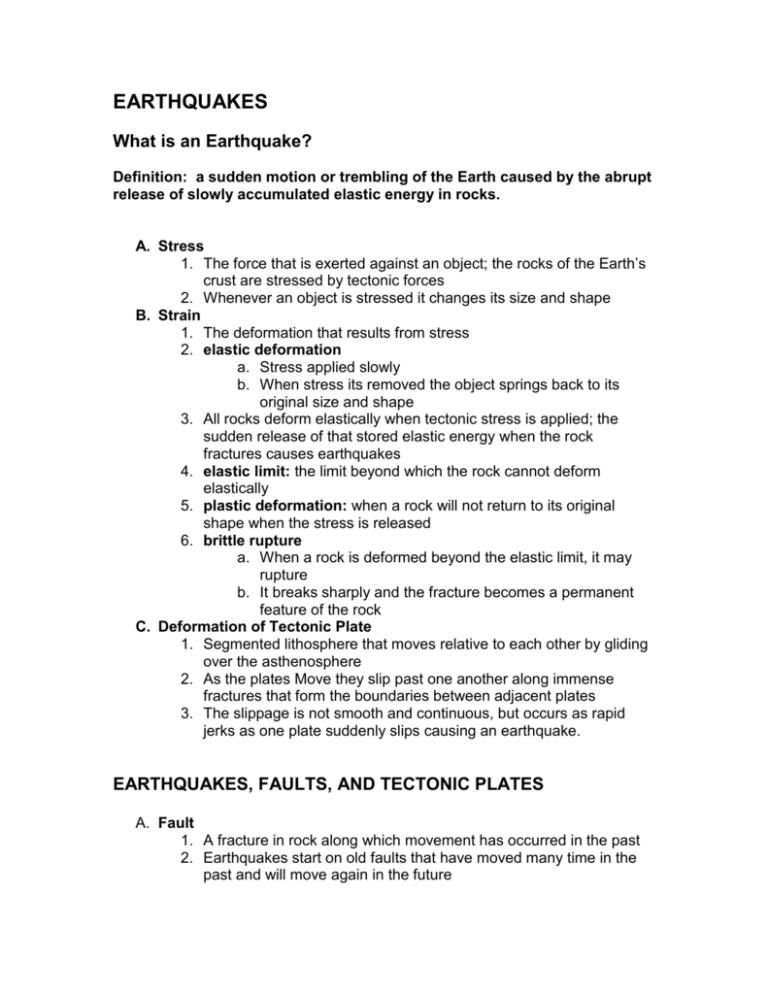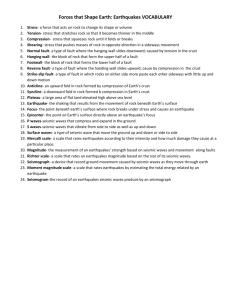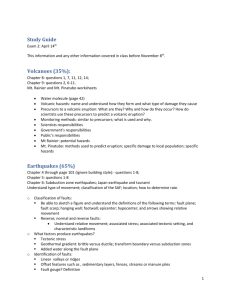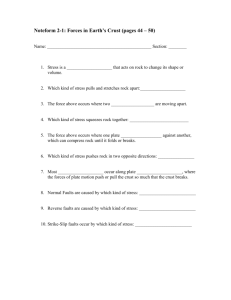earthquakes and humans - FacultyWeb Support Center
advertisement

EARTHQUAKES What is an Earthquake? Definition: a sudden motion or trembling of the Earth caused by the abrupt release of slowly accumulated elastic energy in rocks. A. Stress 1. The force that is exerted against an object; the rocks of the Earth’s crust are stressed by tectonic forces 2. Whenever an object is stressed it changes its size and shape B. Strain 1. The deformation that results from stress 2. elastic deformation a. Stress applied slowly b. When stress its removed the object springs back to its original size and shape 3. All rocks deform elastically when tectonic stress is applied; the sudden release of that stored elastic energy when the rock fractures causes earthquakes 4. elastic limit: the limit beyond which the rock cannot deform elastically 5. plastic deformation: when a rock will not return to its original shape when the stress is released 6. brittle rupture a. When a rock is deformed beyond the elastic limit, it may rupture b. It breaks sharply and the fracture becomes a permanent feature of the rock C. Deformation of Tectonic Plate 1. Segmented lithosphere that moves relative to each other by gliding over the asthenosphere 2. As the plates Move they slip past one another along immense fractures that form the boundaries between adjacent plates 3. The slippage is not smooth and continuous, but occurs as rapid jerks as one plate suddenly slips causing an earthquake. EARTHQUAKES, FAULTS, AND TECTONIC PLATES A. Fault 1. A fracture in rock along which movement has occurred in the past 2. Earthquakes start on old faults that have moved many time in the past and will move again in the future 3. If new stresses develop in a region of the crust, new faults form and earthquakes can occur in places that were previously earthquake free. 4. fault creep a. Slow movement of plate past one another at a continuous snail-like pace b. The movement occurs without violent and destructive earthquakes c. seismic gap: fuzzy area on graph B. Tectonic Plates 1. Most earthquakes occur along the faults separating tectonic plates 2. Less commonly, earthquakes occur where thick piles of sediment have accumulated a. Causes of earthquakes in plate interiors are not as well understood b. Some interior quakes occur where thick piles of sediment have accumulated c. Other interior quakes may be caused by plate movements d. Rebound: “ Isostasy” over central US because of glacial covering EARTHQUAKE WAVES A. Body Waves 1. Seismic Waves a. waves that travel through rock b. initiated naturally by earthquakes c. can also by produced artificially by explosive charges detonated on or beneath the Earth’s surface 2. seismology: the study of earthquakes and of the structure of the Earth’s interior from evidence provided by seismic waves 3. body waves a. travel through the interior of the Earth b. start from the initial rupture point, or focus, of an earthquake. c. Epicenter: point on the Earth’s surface directly above the focus 4. primary wave- also called p-wave a. formed by alternate compression and expansion of the rock—like a slinky. b. Transmitted in both liquids and solids c. Travels at speeds of 5-7 km/sec in the crust and 8 km/sec in the upper mantle d. The first wave to reach an observer. 5. Secondary wave--also called S-wave a. Form when shearing forces are transmitted b. Travel at speeds between 3-4 km/sec in the crust c. Move only through solids B. Surface waves 1. L-Waves: “Surface Waves” a. Two types of L-waves Up-and-down motion Side-to-side vibration 2. Surface waves cause the most property damage because of the ground motion associated with them C. Measurement of seismic waves 1. seismograph: a device that graphs seismic waves 2. seismogram: the record of an earth vibration 3. An earthquake measuring station generally has at least three seismographs a. two horizontal seismographs oriented to measure east-west movements oriented to measure north-south movements b. one vertical seismograph LOCATING THE SOURCE OF AN EARTHQUAKE A. Time-travel Curves 1. Graphs used to quantify the general relationship between distance from an earthquake epicenter and arrival times of the different types of quakes 2. to create a time travel graph one must know both when and where the earthquake occurred 3. graph can then be used to measure the distance between a recording station and an earthquake whose epicenter is unknown EARTHQUAKES AND HUMANS A. Measurements of earthquake strength 1. Mercalli Scale: a qualitative scale of earthquake intensity and measures the effects of an earthquake at a particular place 2. Richter scale a. A quantitative scale of earthquake magnitude based on measurements made by a seismograph b. first refined by Charles Richter in 1935 c. The magnitude is determined by measuring the amplitude of the largest wave recorded by a seismograph. Adjustments are made for the distance from each recording station to the earthquake d. Scale is logarithmic 1. An increase of one unit on the scale represents a 10fold increase in the amplitude of a recorded earthquake wave 2. An increase of one unit on the scale corresponds approximately to a 30-fold increase in energy related during the quake B. Earthquake Damage 1. Ground motion a. Motion of ground is dependent upon the rock and the soil type b. Some types of building materials and design features are more able to withstand an earthquake than others 2. Permanent alteration of landforms Scarps: a short, steep cliff formed by the vertical displacement of land by an earthquake (ex: Balcones Escarpment) 3. Fire 4. Landslides 5. Tsunamis: Seismic sea wave caused by displacement of the sea floor EARTHQUAKE PREDICTION A. Long-Term Prediction 1. Motion along a fault a. On segments of the fault where fault creep occurs, the plates slip past one another smoothly and without major earthquakes b. In other segments of the fault, the plates “hop” past one another in a series of small jumps causing numerous, small, nondamaging earthquakes c. In still other segments of the fault, plates become locked for tens to hundreds of years and then produce catastrophic earthquakes when they break free. 2. Seismic gap a. An immobile region of a fault bounded by moving segments b. Rock within the seismic gap is accumulating elastic deformation and will eventually fracture producing a major earthquake 3. Historical studies of earthquake activity make it relatively easy to identify zones of high earthquake hazard. B. Short-Term Prediction 1. A reliable early warning system; a signal or group of signals that immediately precedes an earthquake 2. Foreshocks a. Small earthquakes that precede a large quake by an interval ranging from a few seconds to a few weeks b. Only about ½ of the major earthquake sin recent years were preceded by a significant number of foreshocks/ 3. Measure change in the shape of the land; distortions of the crust may precede major earthquakes. 4. release of radon preceding an earthquake 5. strange animal behavior preceding an earthquake C. Social and Economic Factors in Earthquake Prediction Short-term earthquake prediction is not only a formidable scientific problem but it also involves political, social, and economic issues. STUDING THE INTERIOR OF THE EARTH A. Seismic Tomography 1. Geologists use seismic waves to study the interior of the Earth 2. Properties of waves a. In a uniform homogeneous medium, a wave radiates velocity b. The velocity of a seismic wave depends on the nature of the material that travels through; i.e. its rigidity and density c. When waves pass form one material to another, they refract (bend) d. P-waves are compressional waves and travel through all media—gases, liquids, and solids—whereas 3-waves are only transmitted through solids. 3. In a uniform and homogeneous Earth waves will radiate form the focus of an earthquake in concentric spheres and travel uniformly through the planet. Uniform propagation of waves is not observed. B. Discovery of the core 1. Shadow Zone a. No direct waves are defected beyond 105 degrees from the focus b. Caused by a discontinuity deep in the interior of the Earth c. The shadow zone exists because of refraction of the pwaves at the mantle-core boundary and the failure of swaves to pass through 2. The failure of s-waves to pass through the outer core, and the refraction of p-waves shows that the core is composed of an inner solid sphere surrounded by an outer liquid sphere. C. Discovery of the Crust-Mantle Boundary Mohorovicic Discontinuity (Moho): the boundary between the crust and the mantle was first identified as the boundary between different types of rock that transmit waves at different velocities. THE EARTH’S INTERIOR Seismic Tomography: The study of the Earth’s interior indirectly by studying the action of seismic waves. This information was discovered by seismic interpretation A. The Crust 1. The outer shell of the Earth 2. Oceanic crust a. 7-10 km thick b. p-waves travel through oceanic crust (basaltic composition) at 7 km/sec 3. Continental crust a. 20-70 km thick b. p-waves travel through continental crust (granitic composition) at 6km/sec B. The Mantle 2. 2900 km thick and comprises about 80% of the volume of the Earth 3. Large quantities of basalt magma originate in the mantle 4. The layer within the mantle a. Upper mantle --Extends form the base of the curst downward to about 670 km beneath the surface --composed primarily of peridotite -- subdivided into three layers 1. lithosphere—crust and uppermost part of the mantle—where most earthquakes occur 2. asthenosphere – extends from the base of the lithosphere to a depth of 350 km 3. low-velocity layer—separates lithosphere form asthenosphere C. Outer Core – known to be liquid because of the behavior of seismic waves. It is speculated that the material is liquid iron and nickel. D. Inner Core – known to be solid because of the behavior of seismic waves and is thought to be solid iron and nickel. Geologic Structure MOUNTAIN AND MOUNTAIN RANGES A. Mountain 1. any part of the Earth’s surface sufficiently elevated above its surroundings to have a distinct summit and to be considered worthy of a name 2. peaks must rise at least 300 m above the surrounding terrain B. Mountain Range 1. a series of mountains or mountain ridges that are closely related in position, direction, age, and mode of formation 2. a group of mountain ranges found grouped together in an elongate zone is a mountain chain PLATE TECTONICS AND MOUNTAIN BUILDING A. Orogenic Activity 1. orogeny refers to the process of mountain building 2. an orogen or orogenic belt is a long and relatively narrow region near a tectonically active continental margin where any or all of those processes have formed mountains B. Orogenic Activity and Plate Boundaries 1. rift boundary a. mid-oceanic ridge b. continental rifting is responsible for the uplift 2. transform fault boundary a. high cliffs and escarpments form along transform faults offsetting the mid-oceanic ridge 3. convergent plate boundaries’ a. ocean-ocean convergence 1. volcanic mountain ranges b. ocean-continental convergence 1. volcanic mountain ranges b. continental-continental convergence 1. folded mountain belts DEFORMATION AND RUPTURE OF ROCKS A. Tectonic Stress 1. tectonic force applied to rocks 2. three types of stress’ a. compressive stress-- squeezes rock and tend to shorten distances parallel to the squeezing direction b. tensional stress --pulls rock apart --the opposite of compressive stress and tends to increase the distance parallel to the stress c. shear stress --acts in parallel but opposite directions --deforms rock by causing one part of a rock mass to slide past another B. Strain 1. the distortion or deformation that results from stress 2. rocks can respond to tectonic stress in 3 different ways a. elastic strain --directly proportional to the amount of stress b. nonelastic strain -- a rock undergoes plastic deformation c. rupture -- rock breakage C. Factors Controlling Rock Response to Stress 1. the nature of the material -- all rocks first react to stress with small amounts of elastic deformation -- with continuing stress, different types of rocks may behave in different ways 2. temperature -- the higher the temperature the greater the tendency of rocks to behave in a plastic manner 3. pressure -- high pressure favors plastic behavior 4. time -- stress applied over a long time, rather than suddenly, also favors plastic behavior of rocks GEOLOGIC STRUCTURES A. Definitions 1. geologic structure -- any feature produced by deformation of rocks 2. fold -- a bend in rock 3. fault --a fracture along which rock on one side has moved relative to rock on the other side 4. joint -- a facture without movement of rock on either side of the break B. Folds 1. anticline--a fold arching upward 2. syncline--a fold arching downward 3. limb--sides of a old 4. fold axis—a line dividing the two limbs of a fold and running along the crest of an anticline or the trough of a syncline a. plunge: when the axis in inclined or tipped at an angle b. plunging fold: a fold with a plunging axis 5. axial plane: an imaginary plane that runs through the axis and divides a fold as symmetrically as possible into two halves 6. types of folds a. a monocline: has only one limb b. anticline c. syncline d. dome: a circular or elliptical anticlinal structure e. basin: a circular or elliptical synclinal structure 7. folding always results in shortening of distances in rocks, and in turn, shortening is produced by compression, reflecting compressional tectonic stress -- folding is less commonly formed during crustal extension C. Faults 5. slip is the distance that rocks on opposite sides of a fault have moved 6. numerous closely spaced factures collectively is referred to as a fault zone 7. repeated movement of faults and fault zones a. tectonic stress commonly continues to be active in the same place over long period of time b. once a fault forms, it is easier for movement to occur again along the same fracture than for a new facture to develop nearby 8. ore deposits often concentrate in faults --miners referred to the side of a fault that hung over their heads as the hanging wall and the side they walked on as the footwall. 9. normal fault -- a fault in which the hanging wall moves down relative to the footwall a. normal faults result form extensional tectonic force b. graben – a wedge-shaped block of rock that has dropped downward between two normal faults 10. reverse fault – a fault in which the hanging wall move up relative to the footwall a. thrust fault – a special type of reverse fault that is nearly horizontal 11. strike-slip fault – the fault is vertical, or nearly so, and the motion along the fault is horizontal -- transform faults that offset the oceanic ridge are special types of strike-slip faults D. Joints 1. a facture similar to a fault except that rocks on either side of the facture have not moved 2. examples of joints a. columnar joints in basalt -- occurs when basalt cools and shrinks causing polygonal cracking b. exfoliation of granite -- sometimes called sheet jointing -- caused by distortion of the rock at shallow depth 3. joints become less abundant with increasing depth because both pressure and plastic behavior of rock increase with depth and both inhibit jointing. E. Strike and Dip 1. strike: the direction in which tilted layers of rock are oriented -- always given as a compass direction 2. dip: the angle of inclination of the bedding plane -- measured from a horizontal plane 3. strike and dip are used to measure any type of layering or other flat surfaces in rocks F. Geologic Structures and Plate Boundaries 1. each of the 3 different types of plate boundaries is characterized by different large-scale tectonic stresses a. spreading centers are extensional b. b. transform boundaries are regions of crustal shearing c. convergent boundaries are dominated by compression. 2. different geologic structures are commonly associated with each of the types of boundaries a. divergent boundaries produce normal faults, grabens, and little or no folding of rocks b. transform plate boundaries are strike-slip faults c. convergent continent plate boundaries commonly associated with folding are reverse and thrust faulting at convergent continent-ocean or ocean-ocean boundaries subduction is accompanied by crustal extension and normal faulting ISLAND ARCS A. Subduction Complex 1. The area in front of the island arc 2. subduction of plate high deforms sediment and part of the oceanic crust 3. growth of the subduction complex occurs by addition of the newest slices at the 4. bottom of the complex a. underthrusting forces the subduction complex upward, forming a sedimentary basin called a forearc basin between the complex and island arc b. the forearc basin fills with sediment derived form erosion of the volcanic islands and becomes a part of the island arc THE BUILDING OF TWO MOUNTIAN CHAINS: THE ANDES AND THE HIMALAYAS A. Similarites and Differences 1. immense and great height of the peaks are similar 2. both rise abruptly from adjacent low-lying regions 3. igneous rocks are the most abundant rock type in the Andes 4. highly folded and thrust-faulted sedimentary and metamorphosed sedimentary rocks dominate Himalayan geology 5. both chain formed at convergent plate boundaries a. Andes at ocean-continental collision’ b. Himalayas at a continental-continental collision B. The Andes: Subduction at a Continental Margin 1. Today the Andes are a relatively narrow mountain chain consisting predominantly of volcanic and plutonic rocks produced by subduction at a continental margin a. the chain also contains extensive sedimentary rocks deposited in basin that formed by sinking of the crust on both sides of the mountains b. some of these rocks were deformed and metamorphosed by tectonic forces and elevated temperature and pressure related to the emplacement of huge volumes of magma into the crust c. this type of a plate margin is called an Andean margin. C. The Himalayan Mountain Chain: A Collision Between Continents. 1. formation of an Andean-type margin 2. continent-continent collision -- India and Asia 3. Himalayas today a. The combination of underthrusting of India beneath Tibet and the horizontal squashing of Tibet has produced unusually think continental crust beneath the Himalayas and the Tibetan Plateau b. Frequent moderate earthquakes and occasional large and destructive ones characterize the region. 4. the junction between two welded continents is called a suture zone or a continental suture a. recognized by a lack of continuity between rock types, ages, and structures on either side of the suture b. rocks of the suture zone are commonly deformed and sheared by the collision c. bits and scraps of oceanic crust and mantle occur in suture zones.









